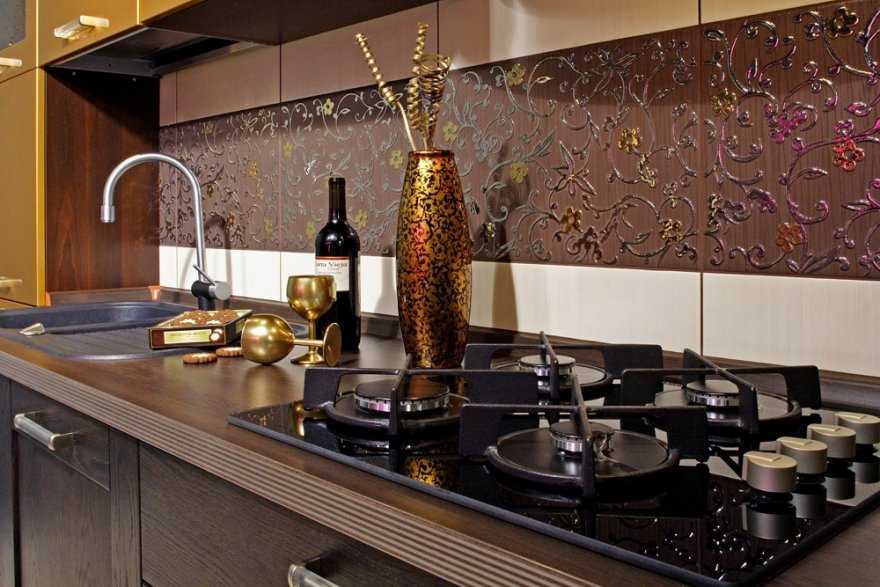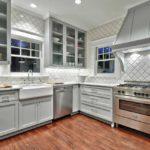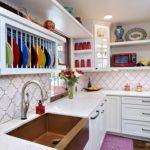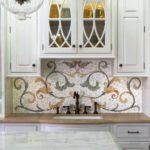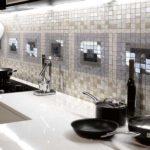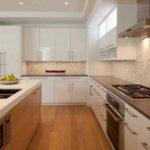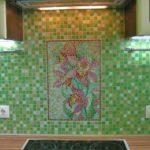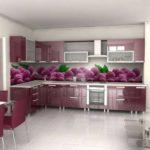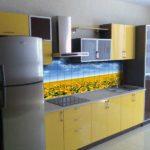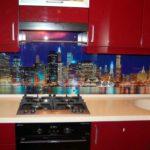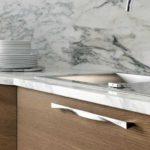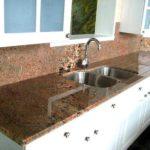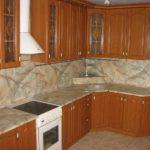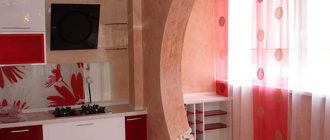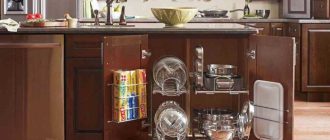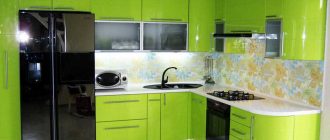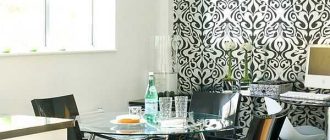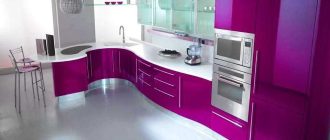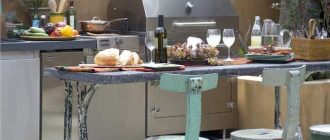One of the most important elements of kitchen design is the apron – the part of the working wall between the hanging and floor cabinets. This area gets the most dirt, especially around the sink and stove, so along with aesthetic requirements, the materials for finishing are subject to strict requirements for practicality. Only then the apron for the kitchen can be considered good, when it is pleasant to look at and easy to care for.
Isi artikel
What do they make of
A few decades ago, and the question of what to make an apron in the kitchen did not arise: if you are lucky enough to find a tile, made of it, if not – just painted with oil paint. As one of the options – glued ordinary paper wallpaper, which were covered with varnish. That’s the whole choice. Naturally, tiles in this case – the best of the possible options.
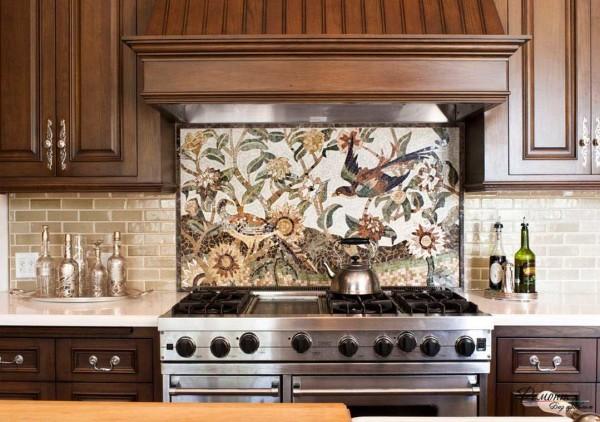
Today, the choice is much wider. There are both traditional tiles and many other materials for the apron for the kitchen:
- Ceramic tiles and mosaics.
- Tempered glass with applied photoprinting.
- Stone and materials on its basis (porcelain stoneware, for example).
- MDF.
- Plastic and plastic panels.
- Metal.
Despite the abundance of materials, ceramic tiles are still the most popular. And all because there it is in a very wide range of colors and sizes. The second in prevalence is an apron of plastic – it is easy to care for, and it is also inexpensive. Therefore, it is popular. In third place, perhaps, kitchen apron of glass. And all because it gives unusually wide possibilities of design and decoration. The only disadvantage is its high cost. All other ways of decorating the wall of the working area are not very popular. Some because of not the best qualities (MDF, for example, is not very fond of moisture and high temperature) or the complexity of installation on the walls (porcelain stoneware and stone). Nevertheless, all of these materials can be used.
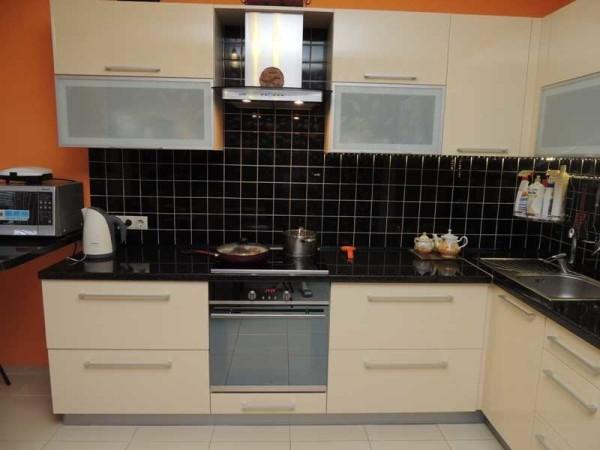
Dimensi
There are usually no questions about the length: the whole wall or part of it, which is occupied by the kitchen set, requires special care. Therefore, with the length of everything is simple. But the width of the tiled area should be larger than the open space. That is, the finish should start below the level of the countertop of floor cabinets and end above the level where the pendant cabinets end. This margin is desirable in the neighborhood of 5 cm. More or less depends on the size of the finishing material, in particular ceramic tiles.
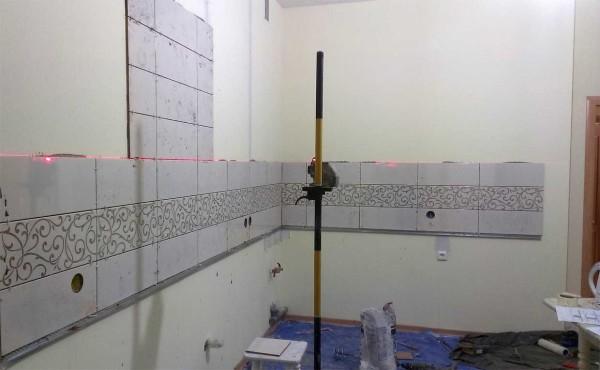
Since there are no cabinets above the stove, the apron in this place is made higher. And again: its width should be such that hinged on the sides of the cabinets with their side lying on the tiles. It is more convenient to clean in this way.
About the design of the kitchen-living room you can read here.
Tile apron
The most traditional type of finishing the working wall in the kitchen – ceramic tiles. It is good because it is easy to clean, has a long service life. Modern technology allows you to make it in different shapes, colors and sizes, which gives a wide range of possibilities for decoration.
The disadvantage of tile apron in the kitchen – the complexity and duration of installation, the high price of the tile itself and installation work. The disadvantage can be considered and the presence of a large number of seams. They are grouted with special compositions, but it is the seams get dirty and lose attractiveness above all. You have to remove the old grout and process them again with new grout.
Nevertheless, it is the apron of tiles is most often made in kitchens. Tiles can be small in size – a square with a side of 12-15 cm.
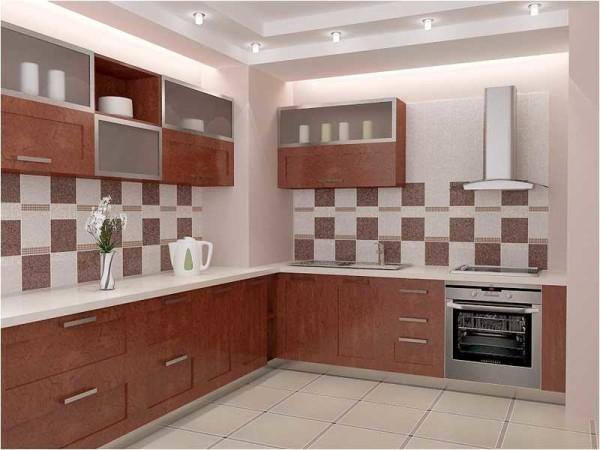
There are tiles in size more reminiscent of bricks: rectangular shape. This form of tile is also called “boar”. It is more difficult to lay it – more seams, but the look of the apron turns out interesting. You can find a model “under the brick”, and you can make a blue or green color. All look good.
There are large-format ceramics. It can have dimensions with a side of 60-70 cm. And it can be both square and rectangular. You can choose such a model that one unit will overlap the entire height of the apron. This is good in that such an apron has fewer seams.
There are collections of tiles of different non-linear shapes, with patterns. They look great, of course, but in the care is more difficult: all the cracks, irregularities and bends to scrub more difficult than a flat surface. Another disadvantage of such tiles – high price, much higher than the average. If all this does not scare you, keep in mind that you need to order it with a reserve of about 10%. First, inevitable waste when laying, secondly, there is a fight at delivery, thirdly, if you are a little wrong calculations, you will have to wait again for a long time, and not the fact that such a tile will be. Many collections are produced in very limited quantities. And they simply may not be. For the same reason, it is always necessary to leave a few pieces in case of repair. After a few years, even mass collections are removed from production.
- Tiles of non-linear shape, also convex
- Tiles of the same shape, but the seams are rubbed with a colored compound
There are also ceramic mosaics – very small tiles, from which you can assemble entire panels. It is even more difficult to lay, but the wall turns out very spectacular.
- You can make patterns out of mosaics
- There are ready-made patterns, fixed on a grid. It is easier to work with them: a grid with tiles fixed on it is laid on the mortar, the seams are grouted with a contrasting or tone-on-tone paste.
- Beige shades are always relevant, and in the case of mosaics, several shades create a voluminous color
- Green color in the kitchen is popular: it combines well with many other colors
There is another type of ceramic tile – with photoprinting. On the ceramic surface before firing is applied with special ink drawing. After it is covered with glaze and fixed at high temperature in the kiln. This technology can be applied even photos, but for kitchen aprons more often choose fruit or flowers.
- This is a photoprint on ceramics
- A field of sunflowers on the working wall
- Night city on ceramic tiles
As you can see, just the options of tile apron to the kitchen is already a lot. And there are 5 other materials.
Features of the design of a small-sized kitchen are described here.
Apron for kitchens made of glass
This type of material began to be used for finishing the working wall in the kitchen relatively recently, but it is quickly gaining popularity. Care for a glass apron is even easier than a tile apron – there are almost no seams, the surface is smooth. You can apply almost any drawing – from smooth coloring to volumetric photography. The technique of applying photo printing to glass is called “skinali”. It is on the aprons in this variant can be applied volumetric 3D drawings.
How to make your own photo printing on glass
The only disadvantage of the glass apron is its high cost. This is due to the complex technology of drawing. But you can make it yourself. The technology is not the same that is used at the enterprises, but craftsmen to that and craftsmen to find a way out of any situation.
To make a glass apron in the technique of skinalyu at home take two glasses of relatively small thickness. If you find or buy tempered – great, but the usual, as practice has shown, serves for a long time. Ask the glass workshop to process the edges and drill holes for fasteners (or do it yourself, if you know how). The two panes of glass should be exactly the same size, and the holes for fasteners should also match.
On one of them glue a film with a picture. This can be a ready-made self-adhesive translucent film, which is sold usually in stores that sell wallpaper. You can order printing on the film of any image in a specialized workshop (perhaps you can help you in the advertising agency, which are engaged in outdoor advertising).
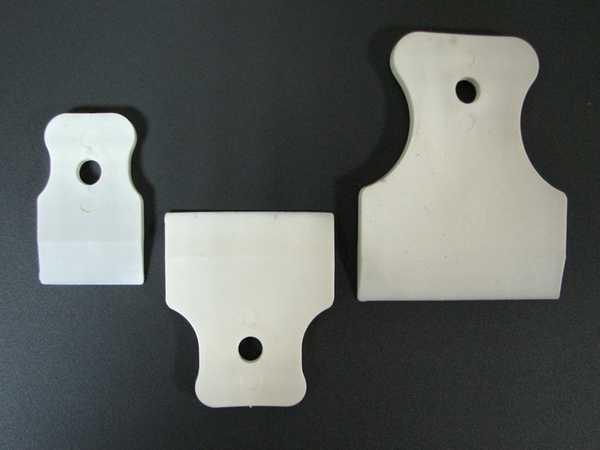
The glass is cleaned of dust, degreased (a mixture of water and dishwashing detergent or glass cleaner), wiped, then sprayed with water from a sprayer. The protective layer is removed from the film and glued to the wet glass on one side: it is more convenient to work on it and less likely to make an air bubble. Then take a dense and elastic material with smooth edges (you can use a rubber spatula) and expel excess water from under the film. The main task is to prevent the appearance of air bubbles. The glued film is left to dry for a few days, and then make holes in it for fasteners.
Both pieces of glass are folded and in this form are attached to the wall. The film turns out to be clamped on both sides and is perfectly protected from any influences. To be sure with time with such an apron nothing happened, the joint around the perimeter should be smeared with silicone sealant (not acrylic, it turns yellow after a while). You can do without the second layer of glass, but then there is a good chance that the film will peel off, or dirt will get behind it, which will be visible.
Read about bar counters and their manufacture here.
Apron of MDF and LDF
If you need to quickly and inexpensively finish the working wall in the kitchen, you can install an apron of MDF panels. You need to choose from moisture-resistant products with a durable coating: you will have to wash often. Therefore, MDF take medium or high density. The greater the density, the better: with a smaller thickness of the panels are more durable, but more dense material is more expensive.
Installed on furniture self-tapping screws or, if necessary, on dowel nails. Beforehand, a hole is drilled in the necessary places. The diameter of the drill bit is the same as the metal rod or slightly smaller. In order that the caps do not stick out, a small depression is made in the panel with a drill bit of a larger diameter than the size of the cap. In a store selling furniture fittings, you can find plugs in the tone of the panel. The diameter of the drill bit can be selected under the plug’s foot so that it becomes tight.
Before mounting on the back surface is applied adhesive composition, then additionally sits on the fasteners. If the apron is obtained from one wall to another – there are no problems, but if there are corners, they must somehow be finished. To do this, you can use plastic or aluminum corners – depends on the style of kitchen furniture (furniture hardware stores).
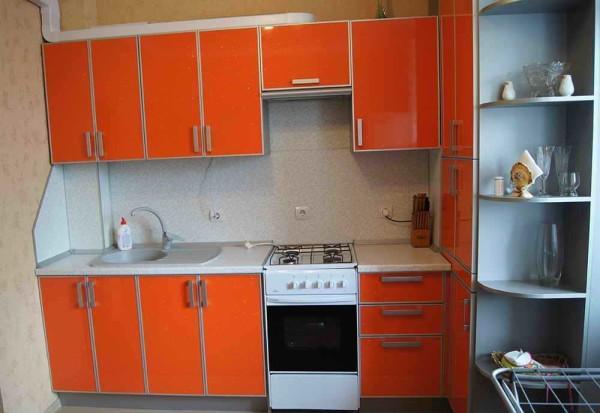
If we talk about color solutions, there are monotone options of different colors, a fairly wide selection of surfaces imitating different types of wood, there is an imitation of stone surfaces. There are also exclusive drawings, such as photo prints, colors, etc.
The drawing is glued on the MDF board. It is a film with photo printing. Since the film must have a high density, such panels cost decently.
About how to choose the right kitchen ganitur and how to arrange the furniture read here.
Plastic
Aprons made of plastic are good because they are inexpensive, mounted simply. At the same time, the plastic surface is well washable. For the production of aprons use ABS (ABS) plastic. It is neutral to fats, acids, alkalis, but reacts badly to contact with alcohol. Therefore, it is not possible to wipe with alcohol and alcohol-containing compositions. Physical properties – rigid, strong and at the same time plastic – allow you to make it into housings of household appliances. Even some parts in the interior of the car are made of such plastic. Therefore, kitchen aprons are only part of its application.
The temperature range at which such a plastic apron can be used is from -40°C to +90°C. The only disadvantage is that it does not react well to ultraviolet light. Therefore, it is undesirable to put it in kitchens where the working wall is illuminated from the window.
The choice of colors is wide, and the relatively low price and ease of installation allow you to change the finish, if very bored. On the plastic is applied any image, then it is covered with a double layer of varnish, which protects the picture and prevents scratches. If you try hard, of course, you can scratch it, but accidentally hitting it – hardly. In general, not a bad option. If we talk about the price, the wall panel of plastic, which are used as a kitchen apron, costs from 1.5 to 6 thousand rubles. The width of the panel is 60-80 cm, length 2-3 meters. Some examples of plastic aprons are in the photo gallery.
Mounted wall panels on a relatively flat surface. Spot glue of the “liquid nails” type is applied and the plastic is fixed on it. Its density allows you to hide minor surface defects.
Features of the repair of the kitchen in Khrushchevka are described here.
Of stone and metal
Less often there are aprons for kitchens made of stone. Firstly, they are expensive, and secondly, it is not easy to clean off the scale from them: the surface, even very well treated, has open pores, which are clogged inevitable in the kitchen grease and soot.
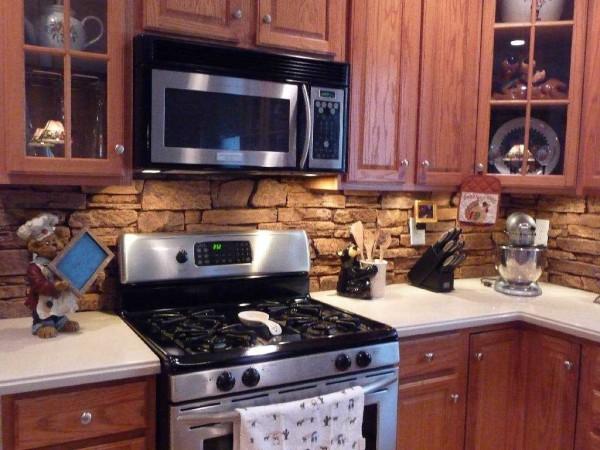
Exceptions – products based on stone, in particular – porcelain stoneware. Its surface can be very smooth. But there is another point: the great weight of such a finish. Accordingly, a complex installation and a powerful fastening system.
- Coloring under marble
- From porcelain stoneware make not only tiles, but also decorate the working walls with them
- The countertop and apron for the kitchen have the same coloring
Decorate the working wall in the kitchen and metal, but this is a very corrosive phenomenon. Fit such an apron is only in minimalism and high-tech, and then you should try to make the room did not look like a shop for cutting meat….
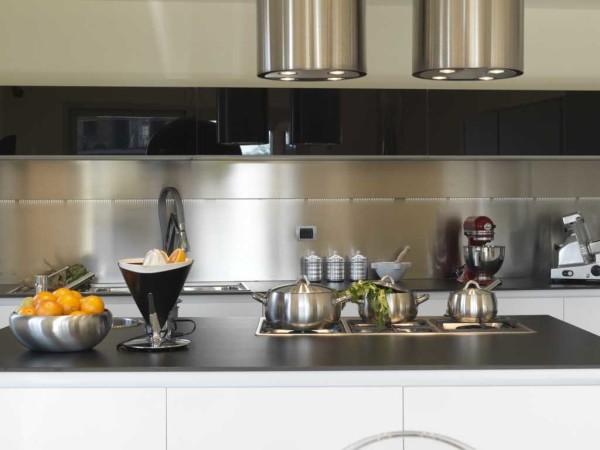
As you can see finish the working wall can be different materials. There are options for different tastes and purses. The main thing – to pick up the apron for the kitchen so that the headset and the rest of the furniture became a single ensemble. Then the kitchen will be cozy.

